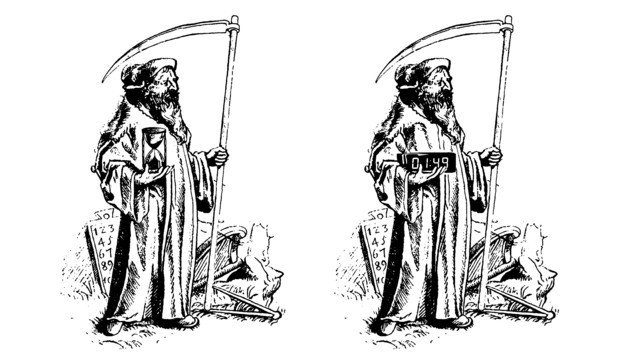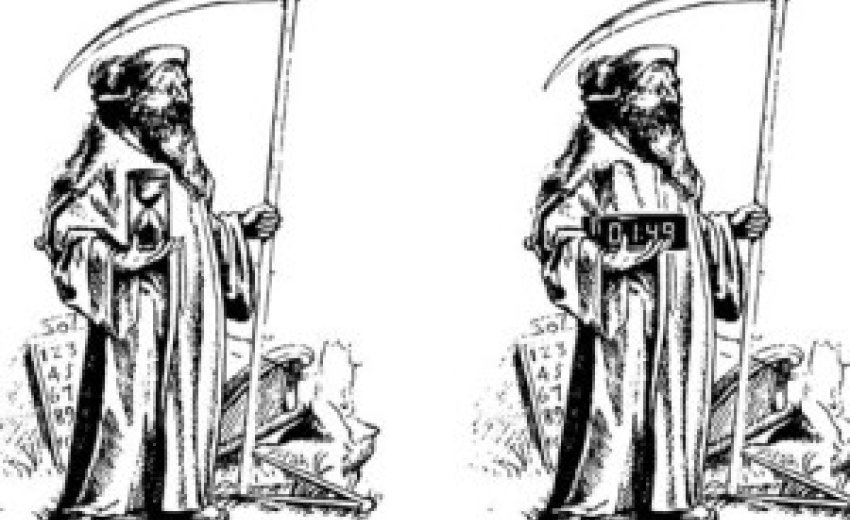 |
| Illustration by O.O.P.S By Richard Cohen Dec 22, 2011 |
“It shall be what o’clock I say it is,” declares Petruchio in “The Taming of the Shrew,” to which his companion Hortensio jovially retorts: “Why, so this gallant will command the sun.” Next month, the 193 member states of the International Telecommunications Union will meet in Geneva and attempt to do exactly that.
Indeed, if a proposal before the body passes, says David Rooney, curator of timekeeping at the U.K.’s Royal Observatory, “It will be the first time that time is not dependent on the rising and falling of the sun.”
First, some history. Over the centuries, man has constantly had to change the way he clocks time, as no method has measured its passing with absolute accuracy. One can go on fiddling with time almost indefinitely (the old joke runs that even a stopped clock is right twice a day, and people will talk about today’s winter solstice making it the “shortest” day of the year).
Back in 1907, Einstein came up with the “equivalence principle,” which states that gravity is locally indistinguishable from acceleration and diminishes as distance increases from the center of mass. This means that time goes faster in, say, Santa Fe, high up in New Mexico, than in Poughkeepsie, down in New York, by about a millisecond per century. A recent experiment on a westward round-the-world jet flight showed that clocks gained 273 nanoseconds, of which about two-thirds of the effect was gravitational.
Because of such natural effects, clocks have been reset to agree with the Earth’s rotation -- thus the distinction between a clock and a chronometer, which ticks on, as undisturbed as possible.
Stargazing in Greenwich
The moment when the sun passes its highest point over Greenwich, in East London, is noon Greenwich Mean Time, which in the late 19th century became the standard by which every timepiece in the world was measured. More recently, however, GMT has had its rivals, including agencies such as the U.S. Naval Observatory in Washington, D.C., the International Earth Rotation Service at the Paris Observatory, and the Bureau International des Poids et Mesures in Sevres, France, all of which employ remarkably sophisticated timepieces.
Today, Universal Time is something of a compromise, based on both the sun’s position in the sky and International Atomic Time, or TAI, a global effort that reckons time using the metallic element cesium.
Some 60 years ago, scientists at the National Physical Laboratory at Teddington, England, discovered that timekeeping calculated by vibrating atoms was more accurate than using the rotation of the Earth. This is because the planet’s spin is slowing down, while the gravitational pull of the sun and moon, plus changes in the molten core beneath our feet, cause our globe to go its own way in space, irrespective of atomic time.
Modern atomic instruments count the tick-tock cycles of cesium, each cycle being the exceptionally fast vibrations of the atoms when exposed to microwaves in a vacuum. Cesium 133 atoms have their 55 electrons ideally distributed for this purpose, all but the outermost being confined to orbits in stable electromagnetic shells. The reactions to microwaves by the outer one can be accurately determined. As the microwaves hit, the electron absorbs and releases measurable packets of light energy. This entails a time measurement inaccuracy of just two nanoseconds per day, or one second over 1.4 million years.
The scientists were still not happy. “It was slightly embarrassing,” says Rooney. “But by the '70s, we needed another fudge factor. So the leap second was introduced, to push together Earth rotation time and atomic vibration time.” These extra seconds are not inserted every year or even on a regular schedule: The last correction was made on Jan. 1, 2008. (It required an extra pip being added to the BBC Radio time signal, a series of short tones at the beginning of every hour.) The time thus regulated is called Coordinated Universal Time, or UTC, and approximates the traditional Greenwich Mean Time to within plus or minus 0.9 seconds.
Forgetting the Sun
For a decade or more a movement has been afoot to take the Earth’s rotation and the sun’s position out of the equation altogether. In late 2004 a draft formula to have time governed entirely by the atomic clock was submitted to the International Telecommunication Union, the United Nations body charged with coordinating information and communication technologies. It did not immediately win favor, but since then the basic concept has been worked on by scientists in several countries, and it has been put forward again for the Geneva conference to decide.
The proposal would not only obviate leap seconds within five years, it would abolish the requirement that time services reconcile the difference between Coordinated Universal Time and the time of day as based on the Earth’s rotation. Such a differential, known as DUT-1, will have to be introduced into numerous software systems that currently have the luxury of pretending it doesn’t exist.
This poses a gigantic problem for our technology-based society -- computers would in effect need to be connected to two clocks, to relate cesium time to the sun-based time-of-day. But then the very word “day” would no longer have a single coherent meaning.
While the proposal has caused intense controversy among scientists, there has been very little comment in the mainstream news media. “It’s a sad train wreck of people not communicating with each other,” says Steve Allen, a senior analyst at the University of California’s Lick Observatory. “The document has been put through without a consensus in the study group commissioned to resolve the question, without a public record of an analysis of requirements, and even without cost estimates of the various alternative options. The research simply isn’t in.”
In October, Allen and a group of like-minded scientists and engineers held a colloquium outside Philadelphia. They recognized that the current methods of timekeeping cost businesses and governments money -- probably several million dollars a year -- but they estimated that the proposed change would cost far more, some $100 million alone to reset the Global Positioning System to the new timing.
Deploying Man-Hours
And there would be other implications, stemming from the globalized technical infrastructure to the legal, historical and economic domains. Allen worries about equipment at his own observatory. Many telescopes were designed in an era when systems that provide civil time were based on the rotation of the Earth. “It would take two man-years’ work just to get the telescopes reset,” he warns.
The situation is even worse for aerospace industries and research. The Hubble Space Telescope, for instance, currently operates by UTC on its computer. This reckoning sets the time for its downlinked data stream, and is also employed for on- board calculations. Were leap seconds discontinued, it would be necessary to alter the on-board software as well as that at ground level.
Celestial navigation, though a backup of last resort, is still widely taught at maritime academies worldwide. In some future emergency, the proposed changes would probably leave navigators (who are often not even aware of the distinction between UTC and GMT) unable to function accurately. One second of time equates to a quarter of a mile navigation error; without leap seconds, UTC would diverge from Greenwich Time at an accelerating pace as the decades pass.
Legal and cultural issues arise, too. Many legal agreements employ the phrase, “time is of the essence.” This may seem irrelevant in the short term, but over a century or two, large international contracts will provide ample opportunities for conflict. The Chinese, among others, have raised cultural objections. “Most Chinese scholars think it is important for time-keeping to have a connection to astronomical time because of traditional Chinese culture,” says Chunhao Han of the Beijing Global Information Center of Application and Exploration.
Lastly, there are the effects the change would have on all of us. “Psychologically it will be very strange,” Allen says. “You’d be telling people that time is nothing to do with time.”
Lacking Diligence
Rob Seaman, a senior software systems engineer at the National Optical Astronomy Observatory in Tucson, Arizona, compares the proposed change unfavorably to the way scientists prepared for the so-called Millennium Bug before 2000. “The new millennium was inevitable, so resources were marshaled, things happened,” he recalls. “Those making the current proposal haven’t performed due diligence. Does air traffic control have embedded assumptions about mean solar time or Earth orientation? How about global shipping? Nobody has looked.”
Why would scientists rush into something like this? In part, it is an extension of a turf war between an alphabet soup of international agencies: ITU-R (the Radiocommunication Sector of the International Telecommunication Union), CGPM (the General Conference of Weights and Measures), IERS (the International Rotation and Reference System Service) and BIPM (the International Bureau of Weights and Measures). “It’s quite a zoo of little bureaucracies,” Seaman says. “There exists an extraordinary tolerance for imprecision within a community that prides itself on precision.”
Proponents of the change seem to have the momentum. “Most delegates will think, this proposal’s been put forward, it must have been researched, it must be all right,” a concerned Allen says.
The motion is just one of many to be considered in Geneva next month, and has been put together by a small group that has obtained letters of approval from various agencies in their governments. So at the very least it will receive a surprisingly large number of “yes” votes from people who are not educated on the issue. So, while there is a significant likelihood that it may indeed get through, only time will tell.
(Richard Cohen, the author of “Chasing the Sun: The Epic Story of the Star That Gives Us Life,” is writing a book on the history of historians. The opinions expressed are his own.)

